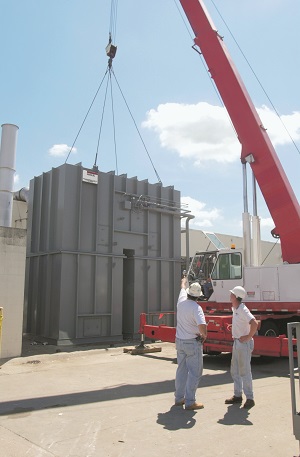The Challenge
A Midwestern outboard engine manufacturer bought a three-year-old plant to produce its marine engines. When finished, the engines are removed from the assembly line and run for quality control. The 25,000 SCFM (40,125 Nm3/hr) of exhaust from testing contains volatile organic compounds (VOCs) that require regulatory compliance. Also within this exhaust is a great deal of water vapor and carbon monoxide (CO).
Anguil had already planned to equip this plant with pollution control equipment for its paint processing operation using a new Anguil Emissions Concentrator coupled with an existing 17,000 SCFM (27,285 Nm3/hr) Regenerative Thermal Oxidizer (RTO) that the company inherited with the plant. However, the engine test cell emission control issue was complicated by the water vapor emitted with the VOCs. Control of the CO emissions was not an objective for this application because its release was not a concern to any local regulatory authority.
The Solution
After a thorough technical evaluation, Anguil engineers chose a new 25,000 SCFM (40,125 Nm3/hr) RTO as the most cost-effective solution for the existing conditions.
The Result
Several factors affected this decision. The presence of a large percentage of water vapor in the process exhaust caused concern regarding the effectiveness of the concentrator type adsorption system. Vapor-liquid separators could be used to minimize the water introduced to the concentrator but the low winter temperatures would require the additional cost of heat tracing and insulation to prevent freezing, increasing the overall cost of the system.

A more suitable technology choice emerged in the RTO. Emissions from the test cells were still low and this technology is extremely cost-effective at low concentrations with 95% thermal energy recovery typically achieved and options for up to 97% thermal energy recovery available. However, the existing RTO coupled to the concentrator controlling the paint processing did not offer the needed capacity or the upgraded materials of construction to provide resistance to corrosion.
Anguil engineers presented their analysis to the customer with all the control options available and the optimal technology chosen for treating the engine test cell emission was a new RTO. The engineering study, which considered the high quantity of water vapor and CO emissions, determined that all ductwork between the test cells and the RTO must be constructed of stainless steel to prevent corrosion. The ductwork was also sloped back to the process entry stream to minimize carryover of excessive amounts of water to the RTO. The oxidizer’s internal insulation and inlet ductwork were also designed to process the high amount of water vapor to minimize erosion of the RTO insulation and corrosion potential of the steel.
The system operation is very energy efficient with thermal energy recovery of 95% or higher. The process air containing VOCs passes through vertical beds of ceramic media that alternately stores and releases heat to elevate the process air temperature before it enters the combustion chamber. Since RTOs have such high heat recovery, the process air can be heated to a value very close to the combustion chamber set-point temperature. Heat released from VOC destruction during oxidation further elevates the process air temperature to the point where the RTO is often self-sustaining with no auxiliary fuel usage.
With this system, they elected to use supplemental fuel injection (SFI) that reduces the point of self-sustained operation to a lower process VOC concentration. Burners are shut off during operation with SFI which minimizes the introduction of combustion air into the chamber, and further reduces operating fuel usage with a flameless design that eliminates NOx emissions from the burner, problematic in some RTOs.
The manufacturing plant is now able to meet compliance on multiple emission sources while saving capitol expense. First, by utilizing equipment inherited with their plant purchase, plus the operational cost savings on the newer more efficient RTO. An additional benefit with selection of an RTO was to the environment. Although not required, RTOs control the CO emissions along with VOCs from the test cells. This facility can accommodate future expansion and stay in compliance for many years to come.


